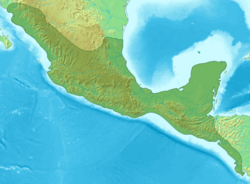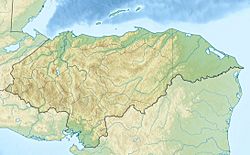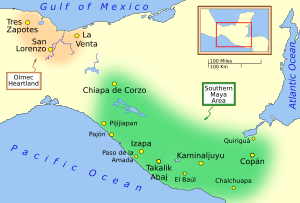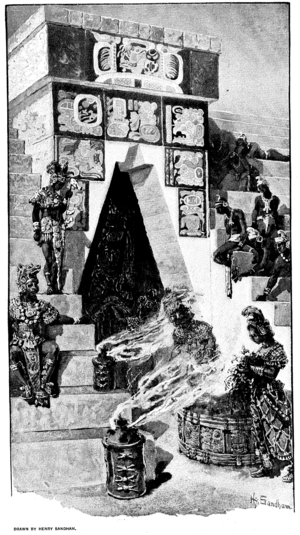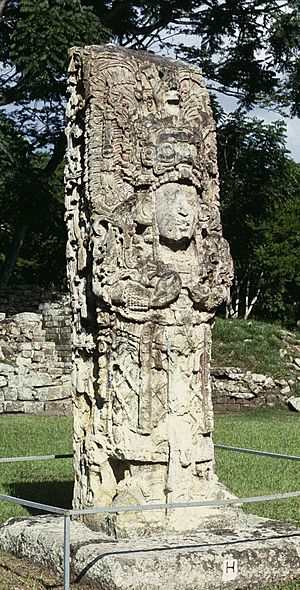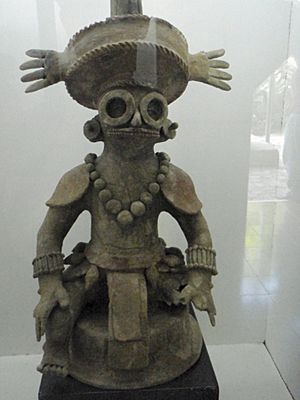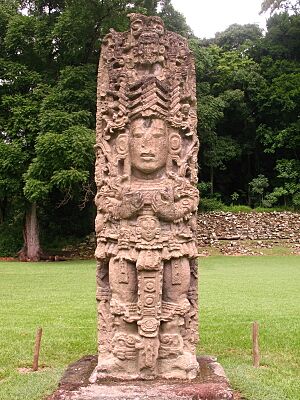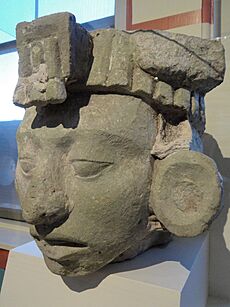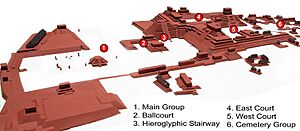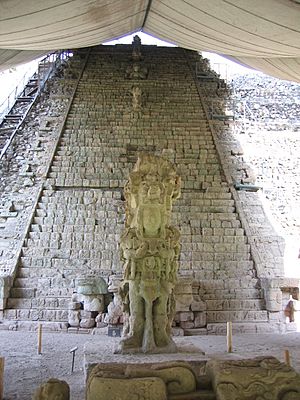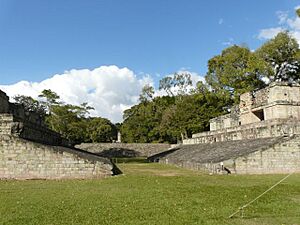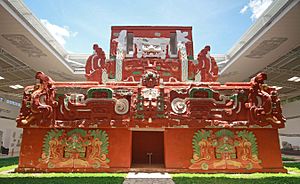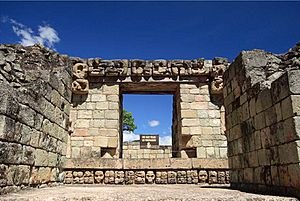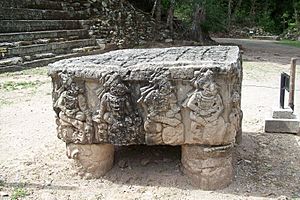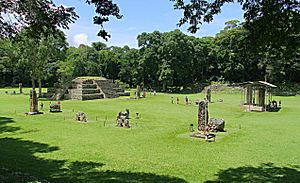Copán facts for kids
|
Oxwitik
|
|
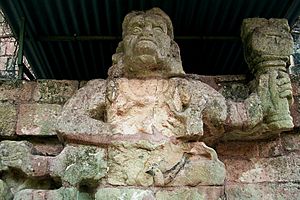
One of two simian sculptures on Temple 11, possibly representing howler monkey gods.
|
|
| Location | Copán Ruinas, Copán Department, Honduras |
|---|---|
| Coordinates | 14°50′15″N 89°08′33″W / 14.83750°N 89.14250°W |
| History | |
| Abandoned | c. 9th century |
| Periods | Early Preclassic to Postclassic |
| Cultures | Maya civilization |
| Site notes | |
| UNESCO World Heritage Site | |
| Criteria | Cultural: iv, vi |
| Inscription | 1980 (4th Session) |
| Area | 15.095 ha |
Copán is an amazing ancient city built by the Maya civilization. It's located in western Honduras, not far from the border with Guatemala. This site is super important for understanding the Maya people. Its old buildings and large public spaces show how the city grew before it was left empty around the early 900s AD.
This ancient Maya city was built in a beautiful, fertile mountain valley. It was the capital of a powerful kingdom from the 400s to 800s AD. Copán was on the edge of the main Maya region, surrounded by groups who were not Maya.
People lived in Copán for over 2,000 years, from very early times until after the main Maya period. The city developed its own special style of sculpture. This unique art might have been a way to show off the Maya identity of its rulers.
Archaeologists and experts who study ancient writing have learned a lot about Copán's history. They have pieced together many details from the Classic period. Copán was a strong city that ruled a large area in the southern Maya lands. However, it faced a big problem in 738 AD. Its powerful king, Uaxaclajuun Ub'aah K'awiil, was captured and killed by the king of Quiriguá, who used to be his helper. This defeat caused a 17-year pause in building new monuments in Copán. During this time, Copán might have even been controlled by Quiriguá.
Over time, the Copán River eroded a large part of the city's main area. To protect the site from more damage, the river was moved. Because Copán is so important to Maya history and has amazing, well-preserved buildings, it was named a World Heritage Site by UNESCO in 1980. The Honduran government also made it a special cultural monument in 1982.
Contents
Discovering Ancient Copán
The ancient name for Copán was likely Oxwitik. This name means "Three Witiks," but what witik means is still a mystery.
Where is Copán Located?
Copán is in western Honduras, very close to the border with Guatemala. It sits in a rich valley among hills, about 700 meters (2,300 feet) above sea level. The main ruins are about 1.6 kilometers (1 mile) from the modern village of Copán Ruinas. This village is built on top of another important Maya area from the Classic period.
Long ago, the Copán Valley floor was uneven and swampy. It often flooded during rainy seasons. In the Early Classic period, the people of Copán flattened the valley. They also built special structures to protect their city from floods. Copán had a big influence on other towns in western and central Honduras. It helped spread Maya culture to local leaders in those areas.
How Many People Lived Here?
When Copán was at its strongest, in the Late Classic period, at least 20,000 people lived there. The kingdom covered an area of over 250 square kilometers (97 square miles). The central part of Copán had between 6,000 and 9,000 people. Another 9,000 to 12,000 people lived in the areas just outside the city center. Plus, about 3,000 to 4,000 people lived in the countryside of the Copán Valley. This means the total population in the valley during the Late Classic period was likely between 18,000 and 25,000 people.
A Look at Copán's History
Not much is known about Copán's rulers before a new royal family took over in the early 400s AD. This new family came from Tikal, another major Maya city. After this, Copán became one of the most powerful Maya city-states. It was a leading power in the southern Maya region.
However, Copán faced a huge defeat in 738 AD. Its former helper state, Quirigua, captured and executed the long-ruling king, Uaxaclajuun Ub'aah K'awiil. Even though this was a big setback, Copán's rulers started building impressive structures again within a few decades.
People continued to live in Copán even after the last big temples and royal monuments were built. But the population slowly went down in the 700s and 800s. It dropped from over 20,000 people to fewer than 5,000. This decline took over four centuries to show signs of a full collapse. This shows how stable the site was, even after the royal families lost power. By the time the Spanish arrived in the 1500s, the main ceremonial center was empty. Only a few farming villages remained in the valley.
Copán's Kings and Queens
We know little about the rulers of Copán before 426 AD. However, later writings mention some earlier leaders.
| Name (or nickname) | Ruled | Dynasty number |
|---|---|---|
| K'inich Yax K'uk' Mo' | 426 – c. 437 | 1 |
| K'inich Popol Hol | c. 437 | 2 |
| Name unknown | c. 455 | 3 |
| Ku Ix | c. 465 | 4 |
| Name unknown | c. 476 | 5 |
| Muyal Jol | c. 485 | 6 |
| B'alam Nehn | 504–544 | 7 |
| Wil Ohl K'inich | 532–551 | 8 |
| Sak-Lu | 551–553 | 9 |
| Tzi-B'alam | 553–578 | 10 |
| K'ak' Chan Yopaat | 578–628 | 11 |
| Chan Imix K'awiil | 628–695 | 12 |
| Uaxaclajuun Ub'aah K'awiil | 695–738 | 13 |
| Ajaw K'ak' Joplaj Chan K'awiil | 738–749 | 14 |
| Ajaw K'ak' Yipyaj Chan K'awiil | 749–763 | 15 |
| Yax Pasaj Chan Yopaat | 763 – after 810 | 16 |
| Ukit Took | 822 | 17? |
The First King: K'inich Yax K'uk' Mo'
The city of Copán was restarted by K'inich Yax K'uk' Mo'. He made it the capital of a new Maya kingdom. This change was likely planned and started from Tikal. Ancient texts say that a warrior named K'uk' Mo' Ajaw became king in 426 AD. He was given a new royal name, K'inich Yax K'uk' Mo'. He also received the title "Lord of the West," which was used by a general from the great city of Teotihuacan. K'inich Yax K'uk' Mo' was probably from Tikal. He might have been supported by Tikal's 16th ruler.
K'inich Yax K'uk' Mo' may have made his claim to the throne stronger by marrying into Copán's old royal family. Bones from his presumed wife show that she was from Copán. After the new kingdom of Copán began, the city stayed close friends with Tikal. A stone altar called Copán Altar Q shows the lord becoming king and receiving his royal staff. The ceremonies to start the Copán dynasty also included setting up a helper king in Quiriguá.
K'inich Yax K'uk' Mo' died between 435 and 437 AD. In 1995, archaeologists found a tomb under a temple. It held the skeleton of an older man with many valuable items. He also had signs of battle wounds. These remains are believed to be K'inich Yax K'uk' Mo'. Bone analysis shows he was not originally from Copán.
K'inich Popol Hol and Early Rulers
K'inich Popol Hol became king after K'inich Yax K'uk' Mo', who was his father. He started big building projects, redesigning the center of Copán. K'inich Popol Hol oversaw the building of the first Mesoamerican ballcourt in the city. It was decorated with images of the scarlet macaw, a bird important in Maya mythology. He also built three new buildings very quickly on top of his father's tomb.
Not much is known about Rulers 3 to 6. Ruler 3 is shown on Altar Q, but his name is missing. Ku Ix was the 4th ruler. He rebuilt a temple and added a special step with hieroglyphs. The next two kings are only known from their images on Altar Q.
B'alam Nehn (also called Waterlily Jaguar) was the first king to record his place in the line of rulers. He said he was the seventh king after K'inich Yax K'uk' Mo'. He was ruling Copán by 504 AD. B'alam Nehn also started major building projects in the Acropolis.
Wil Ohl K'inich, the eighth ruler, is also known only from Altar Q. He was followed by Ruler 9 in 551 AD, who ruled for less than two years. The 10th ruler is called Moon Jaguar by experts. He was the son of B'alam Nehn. He became king in May 553 AD. His most famous building is the beautiful Rosalila phase of Temple 16. This temple was found perfectly preserved inside later versions of the temple.
K'ak' Chan Yopaat and Smoke Imix
K'ak' Chan Yopaat was the eleventh king of Copán. He became king in 578 AD. During his rule, Copán's population grew a lot. People started living in all available areas of the Copán Valley. He ruled for 49 years until his death in 628 AD.
Smoke Imix became king 16 days after K'ak' Chan Yopaat died. He is thought to be the longest-reigning king of Copán, ruling from 628 to 695 AD. He was born in 612 AD and became king at age 15. For the first 26 years, not much building happened. But in 652 AD, there was a sudden burst of new monuments. He built two stelae in the Great Plaza and four more in other important places. These celebrated a special Maya time period. He also built a stela at a site 12 kilometers (7.5 miles) away. It's thought he was trying to show his power across the whole valley.
Smoke Imix continued to rule until almost the end of the 600s. He built nine more monuments and made big changes to Copán's buildings. He built Structure 2, which closed off the north side of the Great Plaza. He also built a new version of Temple 26. Smoke Imix ruled Copán for 67 years and died in 695 AD at age 79. His tomb was ready in Temple 26, and he was buried two days after he died.
The Powerful Uaxaclajuun Ub'aah K'awiil
Uaxaclajuun Ub'aah K'awiil became the 13th king of Copán in July 695 AD. His rule saw Copán's greatest achievements, but also a huge disaster. During his time, the city's sculptures became very detailed and lifelike. In 724 AD, Uaxaclajuun Ub'aah K'awiil put K'ak' Tiliw Chan Yopaat on the throne of Quiriguá as his helper. Uaxaclajuun Ub'aah K'awiil was so confident that he ranked Copán among the four most powerful Maya states, along with Tikal, Calakmul, and Palenque.
He built seven more beautiful stelae until 736 AD. These monuments are considered masterpieces of Maya art. They show King Uaxaclajuun Ub'aah K'awiil in special poses, looking like different gods. The king also did major construction work. He built a new version of Temple 26, which included the first Hieroglyphic Stairway. He also rebuilt the ballcourt.
In 738 AD, a big disaster happened. K'ak' Tiliw Chan Yopaat, the king of Quiriguá, captured Uaxaclajuun Ub'aah K'awiil. Six days later, Uaxaclajuun Ub'aah K'awiil was executed in Quiriguá. This event did not seem to involve a big battle or attack on either city. It suggests that K'ak' Tiliw Chan Yopaat might have ambushed Uaxaclajuun Ub'aah K'awiil. Some think Uaxaclajuun Ub'aah K'awiil was trying to capture people for a ceremony when he was ambushed.
Copán, a much stronger city than Quiriguá, did not fight back. This suggests they feared military help from Calakmul, an enemy of Tikal. Calakmul likely helped Quiriguá to weaken Tikal's ally. This disaster had long-lasting effects on Copán. Major building stopped, and no new monuments were built for 17 years.
Later Rulers and Decline
K'ak' Joplaj Chan K'awiil became the 14th king of Copán in June 738 AD. Not much is known about his rule because few monuments were built after the defeat by Quiriguá. Copán's defeat meant it lost control of the important Motagua River trade route to Quiriguá. Copán's income went down, while Quiriguá's went up. K'ak' Joplaj Chan K'awiil died in January 749 AD.
The next ruler was K'ak' Yipyaj Chan K'awiil, son of the previous king. He started a program to rebuild and recover from the disaster. He built a new Temple 26, making the Hieroglyphic Stairway longer. He also added five life-size statues of seated rulers on the stairway. K'ak' Yipyaj Chan K'awiil died in the early 760s.
Yax Pasaj Chan Yopaat was the 16th ruler. He took the throne in June 763 AD, possibly when he was only 9 years old. He did not build large stelae. Instead, he added hieroglyphic texts to the city's buildings and smaller altars. His mother was a noblewoman from distant Palenque in Mexico. He built a platform for Temple 11 in 769 AD and added a two-story building on top. Around 776 AD, he finished the final version of Temple 16. At its base, he placed the famous Copán Altar Q. This altar shows all 16 rulers of Copán, from the first king to Yax Pasaj Chan Yopaat.
By the late 700s, noble families in Copán became more powerful. They built palaces with carved benches, as fancy as the king's. At the same time, smaller towns nearby started showing their own power. Towards the end of Yax Pasaj Chan Yopaat's rule, Copán was struggling with too many people and not enough resources. Living standards for ordinary people went down.
The last known king, Ukit Took', came to power in 822 AD. He started building a new altar, but it was never finished. The long line of kings in Copán ended. The population of the city collapsed to a small fraction of what it once was. This collapse happened suddenly, between 800 and 830 AD. However, people continued to live in the valley until about 900 AD, and then the population slowly declined. In later times, villagers took stones from the ancient buildings to build their own homes.
Modern Discoveries
The first mention of Copán after the Spanish conquest was in a letter from 1576. French explorer Jean-Frédéric Waldeck visited the site in the early 1800s and drew the ruins. Later, Colonel Juan Galindo and famous explorers John Lloyd Stephens and Frederick Catherwood also visited and wrote about Copán. Many expeditions from the Peabody Museum of Harvard University and the Carnegie Institution worked at Copán in the late 1800s and early 1900s.
The Copán buildings were greatly damaged by nature over the centuries. The Copán River slowly changed its path, destroying the eastern part of the main city area. This erosion revealed layers of ancient buildings, which was helpful for archaeologists. To stop more damage, the Carnegie Institution moved the river south in the 1930s. The dry riverbed was filled in during the 1990s. Unfortunately, some buildings recorded in the 1800s were lost to the river.
| Copán Ruins Cultural Monument | |
|---|---|
| Ruinas de Copán | |
|
IUCN Category III (Natural Monument)
|
|
| Area | .66 km2 (0.25 sq mi) |
| Designation | Cultural monument |
| Designated | 1982 |
| Administrator | Instituto de Conservación Forestal and Instituto Hondureño de Antropología e Historia |
| World Heritage site | Maya Site of Copan (1980) |
UNESCO provided money for various projects at the site between 1982 and 1999. The cultural monument covers 66 hectares (163 acres). Unfortunately, stealing artifacts remains a serious problem at Copán. A tomb was even looted in 1998 while archaeologists were digging it up.
Exploring the Site
The Copán site is famous for its many carved stone monuments, called stelae. Most of these were placed along paths in the city's main plaza and the nearby acropolis. The acropolis is a large area with many overlapping step-pyramids, plazas, and palaces. The site also has a big court for playing the Mesoamerican ballgame.
The site is divided into different areas. The Main Group and the Cemetery Group are in the city center. They are connected by a special road called a sacbe to the Sepulturas Group.
The Main Group
The Main Group is the heart of the ancient city. It covers an area of about 600 by 300 meters (1,970 by 980 feet). Its main parts are the Acropolis, which was the royal complex, and a group of smaller buildings and plazas to the north. These include the Hieroglyphic Stairway and the ballcourt. The Monument Plaza has the most carved monuments at the site.
The Acropolis was the royal area in the middle of Copán. It has two main plazas, called the West Court and the East Court. Both are surrounded by tall buildings. Archaeologists have dug many tunnels under the Acropolis. These tunnels show how the royal complex grew over hundreds of years. They also found ancient texts that confirm details about the early kings of the city. The oldest buildings under the Acropolis date back to the early 400s AD. These early buildings were made of stone and adobe. They were built on top of even older earth and stone structures from before the kings ruled.
Structure 10L-11 is on the west side of the Acropolis. It was likely the royal palace of Yax Pasaj Chan Yopaat, the 16th and last known king of Copán. This building was constructed on top of several older structures. One of these older structures probably holds the tomb of the previous king, K'ak' Yipyaj Chan K'awiil. Yax Pasaj Chan Yopaat built a new temple platform over his predecessor's tomb in 769 AD. On top of this, he added a two-story building with a sculpted roof showing the mythological sky.
| Phase | King | Date |
|---|---|---|
| Hunal | K'inich Yax K'uk' Mo' | early 5th century AD |
| Yehnal | K'inich Popol Hol | mid-5th century AD |
| Margarita | K'inich Popol Hol | mid-5th century AD |
| Rosalila | Moon Jaguar | mid-6th century AD |
| Purpura | Uaxaclajuun Ub'aah K'awiil | early 7th century AD |
Structure 10L-16 (Temple 16) is a temple pyramid. It is the highest part of the Acropolis, located between the East and West Courts. This temple faces the West Court and is dedicated to K'inich Yax K'uk' Mo', the first king. The temple was built on top of the king's original palace and tomb. It is the final version of many temples built on top of each other, which was common for the Maya. The earliest version of this temple is called Hunal. It was built in a style typical of Teotihuacan. The king was buried in a special room under the Hunal temple, with many valuable jade items.
One of the best-preserved parts of Temple 16 is the Rosalila. This temple was built over five earlier versions. Archaeologist Ricardo Agurcia found this almost complete temple while digging tunnels. Rosalila is amazing because it's so well preserved. It even has its colorful painted stucco decorations. Rosalila shows K'inich Yax K'uk' Mo' at the center of a mythical scene. It combines the king with the sky god Itzamna in bird form. The temple also has images of mountains, skeletons, and crocodiles that look like humans. Vents on the outside were made so that smoke from incense burned inside would mix with the sculptures. A life-size copy of the Rosalila building is at the Copán site museum.
Uaxaclajuun Ub'aah K'awiil covered the Rosalila temple with a new version in the early 700s AD. As part of this, an offering was made. It included special flint tools shaped like humans and gods, wrapped in blue cloth. They also found a 5-foot shark, brought to the city from the ocean 42 kilometers (26 miles) away.
Structure 10L-18 is on the southeast side of the Acropolis. It has been damaged by the Copán River. Stairs on the south side lead to a tomb that was robbed long ago. It was probably the tomb of Yax Pasaj Chan Yopaat.
Structure 10L-22 is a large building on the north side of the East Court. It dates to the time of Uaxaclajuun Ub'aah K'awiil. It is the best-preserved building from his rule. The building has an inner doorway with detailed carvings and masks of the mountain god. The outer doorway has a giant mask of a god. This temple was built to celebrate the king completing his first 20-year period in power, in 715 AD. The building symbolically represents the mountain where corn was created.
| Phase | King | Date |
|---|---|---|
| Yax | K'inich Yax K'uk' Mo' | early 5th century AD |
| Motmot | K'inich Popol Hol | mid-5th century AD |
| Papagayo | Ku Ix | mid-5th century AD |
| Mascarón | Smoke Imix | 7th century AD |
| Chorcha | Smoke Imix | 7th century AD |
| Esmeralda | Uaxaclajuun Ub'aah K'awiil | early 8th century AD |
| N/A | K'ak' Yipyaj Chan K'awiil | mid-8th century AD |
Structure 10L-26 is a temple that extends north from the Acropolis. The 10-meter (33-foot) wide Hieroglyphic Stairway goes up the west side of this building. The earliest version of the temple, called Yax, was built during the time of K'inich Yax K'uk' Mo'. The next phase, called Motmot, was built by Yax K'uk' Mo's son, K'inich Popol Hol. This part was decorated with stucco. Underneath was a tomb with a unique burial of a woman, along with many offerings like animal bones, mercury, jade, and quartz.
Smoke Imix built a pyramid over the earlier phases, called Mascarón. This was later developed into the Chorcha pyramid. A tomb was placed inside, likely holding the remains of Smoke Imix. It contained a man's skeleton wrapped in a mat, with valuable jade items, ceramic pots, jaguar furs, and possibly ancient books. There were also 12 ceramic incense burners shaped like human figures, thought to represent Smoke Imix and his 11 earlier kings. Uaxaclajuun Ub'aah K'awiil then covered the Chorcha phase with a new temple, Esmeralda, by 710 AD. This new phase had the first version of the Hieroglyphic Stairway. K'ak' Yipyaj Chan K'awiil built over the Esmeralda phase in the mid-700s. He moved the Hieroglyphic Stairway to his new version, making it twice as long. He also added five life-size statues of rulers dressed as Teotihuacan warriors.
The Hieroglyphic Stairway climbs the west side of Structure 10L-26. It is 10 meters (33 feet) wide and has 62 steps. Stela M and its altar are at its base. A large sculpted figure is in the middle of every 12th step. These figures are believed to show the most important rulers in the city's history. The stairway is named for its 2,200 glyphs, which form the longest known Maya hieroglyphic text. The text is still being put back together because the stone blocks fell when the temple collapsed. The staircase is 21 meters (69 feet) long. It was first built by Uaxaclajuun Ub'aah K'awiil in 710 AD. It was then reinstalled and made bigger by K'ak' Yipyaj Chan K'awiil in 755 AD.
The Ballcourt is just north of the Hieroglyphic Stairway. Uaxaclajuun Ub'aah K'awiil rebuilt it, then tore it down and built a third version. This was one of the largest ballcourts from the Classic period. It was dedicated to the great macaw god. The buildings next to the playing area had 16 mosaic sculptures of macaws. The date the ballcourt was finished is carved on the playing area: January 6, 738 AD.
The Monument Plaza or Great Plaza is on the north side of the Main Group.
Sepulturas Group
The Sepulturas Group is connected to the Main Group by a sacbe, or causeway. This group has many restored buildings, mostly homes for important people. These homes often have stone benches, some with carved decorations, and several tombs.
This area was lived in for a very long time. One house dates back to the Early Preclassic period. By 800 AD, the complex had about 50 buildings around 7 main courtyards. The most important building was the House of the Bakabs. This was the palace of a powerful nobleman during Yax Pasaj Chan Yopaat's time. Part of this group was also home to non-Maya people from Central Honduras. They were involved in trade, bringing goods from their region.
Important Monuments
Altar Q is the most famous monument at Copán. King Yax Pasaj Chan Yopaat dedicated it in 776 AD. It has carvings of the first 16 kings of Copán around its sides. Each king is shown sitting on his name symbol. A hieroglyphic text on top tells about the start of the dynasty in 426–427 AD. On one side, it shows the first king, K'inich Yax K'uk' Mo', giving power to Yax Pasaj. This carving teaches us a lot about how power was passed down in early Maya culture.
The Motmot Capstone is a carved stone that was placed over a tomb under Structure 10L-26. It has finely sculpted pictures of the first two kings of Copán, K'inich Yax K'uk' Mo' and K'inich Popol Hol. They face each other with hieroglyphs between them. The capstone has two dates: 435 AD and 441 AD. The second date is probably when the capstone was put in place.
The Xukpi Stone is a special monument from an earlier part of the 10L-16 temple. It honors K'inich Yax K'uk' Mo'. It has the date 437 AD and the names of both K'inich Yax K'uk' Mo' and K'inich Popol Hol. It might also mention the Teotihuacan general Siyaj K'ak'. This monument was likely used as a carved bench or step. The date on it is linked to the dedication of a temple or tomb, probably K'inich Yax K'uk' Mo's tomb, which was found under the same structure.
Stela 2 was built in the Great Plaza by Smoke Imix in 652 AD. Stela 3 was also built by Smoke Imix in the Great Plaza in 652 AD. Stela 4 was built by Uaxaclajuun Ub'aah K'awiil in the early 700s AD. Stela 7 dates to the time of K'ak' Chan Yopaat. It was built to celebrate a special Maya time period in 613 AD. It has a long text that is still being figured out. Stela 9 was found in the modern village of Copán Ruinas. It was built by Moon Jaguar and dates to 564 AD. Stela 10 was built by Smoke Imix in 652 AD. Stela 11 was an inner column from Temple 18, the tomb of Yax Pasaj Chan Yopaat. It shows the king as the old Maya maize god. Its text might describe the end of the Copán dynasty. Stela 12 was built by Smoke Imix in 652 AD. Stela 13 was built by Smoke Imix in 652 AD. Stela 15 dates to 524 AD, during B'alam Nehn's rule. It is made entirely of hieroglyphic text. Stela 17 dates to 554 AD, during Moon Jaguar's rule. Stela 18 is a piece of a monument with K'inich Popol Hol's name. Stela 19 was built by Smoke Imix in 652 AD. Stela 63 was dedicated by K'inich Popol Hol. It has finely carved hieroglyphic texts. It might have been started by K'inich Yax K'uk' Mo' with more text added by his son. Stela A was built in 731 AD by Uaxaclajuun Ub'aah K'awiil. It says Copán was one of the four most powerful Maya kingdoms. Stela B was built by Uaxaclajuun Ub'aah K'awiil in the early 700s AD. Stela C was built by Uaxaclajuun Ub'aah K'awiil in the early 700s AD. Stela D was built by Uaxaclajuun Ub'aah K'awiil in the early 700s AD. Stela F was built by Uaxaclajuun Ub'aah K'awiil in the early 700s AD. Stela H was built by Uaxaclajuun Ub'aah K'awiil in the early 700s AD. Stela J was built by Uaxaclajuun Ub'aah K'awiil in 702 AD. It was his first monument and stood at the city's eastern entrance. Stela M shows K'ak' Yipyaj Chan K'awiil. It was placed at the foot of the Hieroglyphic Stairway in 756 AD. Stela N was dedicated by K'ak' Yipyaj Chan K'awiil in 761 AD. It was placed at the foot of Temple 11, which is believed to contain his burial. Stela P dates from the reign of king K'ak' Chan Yopaat and was dedicated in 623 AD.
Images for kids
See also
 In Spanish: Copán (sitio arqueológico) para niños
In Spanish: Copán (sitio arqueológico) para niños


